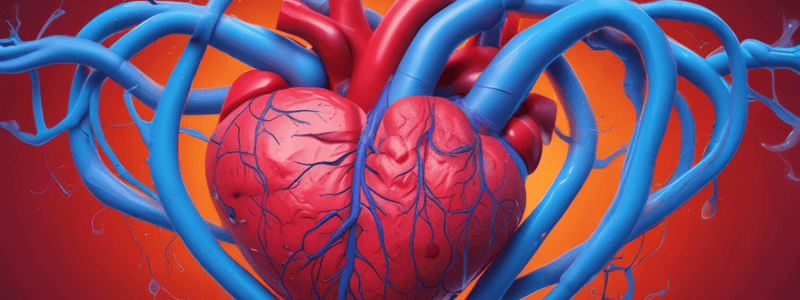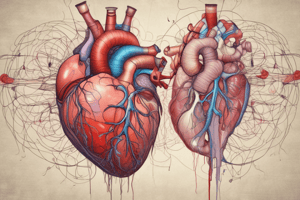Podcast
Questions and Answers
What is the difference between Acquired and Congenital Heart Defects?
What is the difference between Acquired and Congenital Heart Defects?
Which of the following exemplars fall under the category of Increased pulmonary blood flow disorders?
Which of the following exemplars fall under the category of Increased pulmonary blood flow disorders?
What is the lead cause of acquired heart disease discussed in the text?
What is the lead cause of acquired heart disease discussed in the text?
Which disease is described as an inflammatory disease occurring as a reaction to Group A beta-hemolytic streptococcus infection?
Which disease is described as an inflammatory disease occurring as a reaction to Group A beta-hemolytic streptococcus infection?
Signup and view all the answers
Which defect falls under the category of Obstructive Disorders?
Which defect falls under the category of Obstructive Disorders?
Signup and view all the answers
When does Kawasaki Disease typically occur following an untreated or partially treated upper respiratory infection?
When does Kawasaki Disease typically occur following an untreated or partially treated upper respiratory infection?
Signup and view all the answers
Which condition affects the cardiovascular system and can lead to a coronary artery aneurysm?
Which condition affects the cardiovascular system and can lead to a coronary artery aneurysm?
Signup and view all the answers
What is the earliest indication of cystic fibrosis in a newborn?
What is the earliest indication of cystic fibrosis in a newborn?
Signup and view all the answers
Why are antihistamines contraindicated in cystic fibrosis patients?
Why are antihistamines contraindicated in cystic fibrosis patients?
Signup and view all the answers
What test is used to diagnose cystic fibrosis based on sodium and chloride levels?
What test is used to diagnose cystic fibrosis based on sodium and chloride levels?
Signup and view all the answers
Which substance is found in excess in the sweat, tears, and saliva of individuals with cystic fibrosis?
Which substance is found in excess in the sweat, tears, and saliva of individuals with cystic fibrosis?
Signup and view all the answers
What is the role of pancreatic enzymes in cystic fibrosis management?
What is the role of pancreatic enzymes in cystic fibrosis management?
Signup and view all the answers
Why is it important to implement multidisciplinary patient-centered care for individuals with cystic fibrosis?
Why is it important to implement multidisciplinary patient-centered care for individuals with cystic fibrosis?
Signup and view all the answers
What is a common gastrointestinal symptom of cystic fibrosis related to stools?
What is a common gastrointestinal symptom of cystic fibrosis related to stools?
Signup and view all the answers
Which type of vaccine should individuals with cystic fibrosis receive annually?
Which type of vaccine should individuals with cystic fibrosis receive annually?
Signup and view all the answers
What should be encouraged to help individuals with cystic fibrosis avoid respiratory infections?
What should be encouraged to help individuals with cystic fibrosis avoid respiratory infections?
Signup and view all the answers
What are the four diseases mentioned in the first line of the text?
What are the four diseases mentioned in the first line of the text?
Signup and view all the answers
What is one of the recommended actions for patients with certain conditions, according to the text?
What is one of the recommended actions for patients with certain conditions, according to the text?
Signup and view all the answers
Which condition is characterized by muffled heart sounds and pericardial friction rub, according to the text?
Which condition is characterized by muffled heart sounds and pericardial friction rub, according to the text?
Signup and view all the answers
What is chorea indicative of, according to the text?
What is chorea indicative of, according to the text?
Signup and view all the answers
Which of the following is NOT listed as a potential cardiac involvement in Kawasaki Disease?
Which of the following is NOT listed as a potential cardiac involvement in Kawasaki Disease?
Signup and view all the answers
When are prophylactic antibiotics recommended for dental procedures in children with heart disease?
When are prophylactic antibiotics recommended for dental procedures in children with heart disease?
Signup and view all the answers
Which of the following conditions is NOT listed as having the highest risk for infective endocarditis, according to the text?
Which of the following conditions is NOT listed as having the highest risk for infective endocarditis, according to the text?
Signup and view all the answers
What is an important consideration regarding cardiac medications?
What is an important consideration regarding cardiac medications?
Signup and view all the answers
What is the pathophysiology of an Atrial Septal Defect (ASD)?
What is the pathophysiology of an Atrial Septal Defect (ASD)?
Signup and view all the answers
Which clinical manifestation is commonly seen in a patient with an Atrial Septal Defect (ASD)?
Which clinical manifestation is commonly seen in a patient with an Atrial Septal Defect (ASD)?
Signup and view all the answers
Why might a patient with an Atrial Septal Defect (ASD) experience failure to thrive (FTT)?
Why might a patient with an Atrial Septal Defect (ASD) experience failure to thrive (FTT)?
Signup and view all the answers
What is the primary pathophysiology of a Ventricular Septal Defect (VSD)?
What is the primary pathophysiology of a Ventricular Septal Defect (VSD)?
Signup and view all the answers
What is the primary reason for recurrent respiratory infections in a patient with a Ventricular Septal Defect (VSD)?
What is the primary reason for recurrent respiratory infections in a patient with a Ventricular Septal Defect (VSD)?
Signup and view all the answers
What is the pathophysiology of a Patent Ductus Arteriosus (PDA)?
What is the pathophysiology of a Patent Ductus Arteriosus (PDA)?
Signup and view all the answers
What is the primary clinical manifestation of a Patent Ductus Arteriosus (PDA)?
What is the primary clinical manifestation of a Patent Ductus Arteriosus (PDA)?
Signup and view all the answers
What is the reason for performing a respiratory assessment in a patient with Coarctation of the Aorta (CoA)?
What is the reason for performing a respiratory assessment in a patient with Coarctation of the Aorta (CoA)?
Signup and view all the answers
What is the primary cause of epiglottitis?
What is the primary cause of epiglottitis?
Signup and view all the answers
Which age group is most commonly affected by epiglottitis?
Which age group is most commonly affected by epiglottitis?
Signup and view all the answers
What is the recommended approach for diagnosing epiglottitis?
What is the recommended approach for diagnosing epiglottitis?
Signup and view all the answers
Which of the following is a critical component in the management of epiglottitis?
Which of the following is a critical component in the management of epiglottitis?
Signup and view all the answers
What is the recommended position for a child with epiglottitis?
What is the recommended position for a child with epiglottitis?
Signup and view all the answers
What is the significance of the "4 Ds & S" in the assessment of epiglottitis?
What is the significance of the "4 Ds & S" in the assessment of epiglottitis?
Signup and view all the answers
What is the rationale for not visually inspecting the mouth and throat in a suspected case of epiglottitis?
What is the rationale for not visually inspecting the mouth and throat in a suspected case of epiglottitis?
Signup and view all the answers
What is the primary goal of treatment for epiglottitis?
What is the primary goal of treatment for epiglottitis?
Signup and view all the answers




